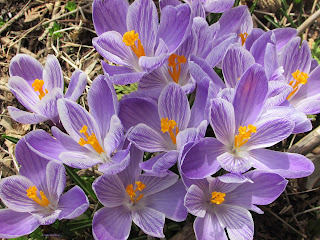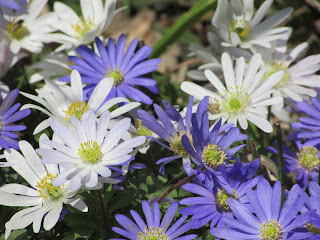The time is here for planting bulbs of those spring blooming plants that are so nice to see when the snow melts and soft breezes waft the aroma of sun percolated soil to our noses. Our eyes crave flowers in spring. But there is another good reason to plant spring blooming bulbs.
 |
| Alliums of all types are bee favorites |
Bees also crave flowers in the spring, in fact they are
vital to bee survival. As bees wake up
and emerge from their winter homes, they go looking for flowers to feed on.
There aren’t many things that bloom as early as spring blooming bulbs, and
whether they are native species or not, bees will be very grateful to you for
planting them.
Bees are attracted to blue, purple, white and yellow flowers
in spring. Red, orange and pink flowers are not visited as much but some of the
early spring flowers in those colors often have a yellow or white center that
will attract bees. Luckily there are many spring blooming bulbs that will fulfill
those bee desires.
Good spring flowering bulbs for bees are crocus, snowdrops, Anemone
blanda (Windflowers), Corydalis solida, hyacinths, Muscari (grape
hyacinths), Eranthus hyemalis (Winter Aconite), Ipheion, Chionodoxa, (Glory of the Snow),
Pushkinia (Squill), Scilla, Ornithogalum (Star of Bethlehem), Erythronium,
(Trout lilies, dogs tooth violets), Camassia, and alliums of all types.
Not all spring blooming bulbs are bee candy. Some common
spring flowering bulbs don’t attract many bees, such as daffodils, narcissus,Fritillaria,
Dutch iris and most tulips. A few species
tulips like T. bakeri and T. sylvestris are bee favorites as well
as Fritillaria meleagris (Guinea Hen flower) in the Fritillaria family.
The bulbs of most bee friendly spring bloomers are small and should be planted in large drifts or groups. Most are inexpensive and buying 25-50 bulbs will cost you little. Plant them closely for the best show. Many of these beauties will multiply for you over the years into larger and more glorious shows.
 |
| Crocus |
Some bulbs like crocus and snowdrops bloom very early,
sometimes through the snow, and other bulbs like alliums bloom later in
spring. Planting a variety of these
small bulbs helps the bees throughout spring. And it keeps the garden looking
pretty too.
And the good news is that many of these early blooming bulbs
are not deer favorites and will be left alone when they bloom. But the bulbs
may be eaten by mice and squirrels shortly after you plant them. And because they are planted shallowly, they
are also subject to being heaved out of the ground during freezing and thawing.
To keep them from being eaten by mice and squirrels do not
use bonemeal when planting. Bonemeal attracts these animals. Also mulch bulbs lightly with chopped straw,
leaves or chipped bark after planting to help disguise the disturbed soil. This
also helps to prevent frost heaving.
If you plant the bulbs early you can often tuck them under
perennial plants like hosta and daylilies and the pests will be less likely to
find them. They will come up and bloom before your perennials get large.
Small spring blooming bulbs are excellent to plant under deciduous trees in woodland settings. They will complete their life cycles before the shade gets dense in most cases. But they are also nice in the front of beds and close to the house so you can see them in early spring when you really need to see flowers. The bees will find them wherever you plant them.
 |
| Glory of the Snow |
Most of the bulbs mentioned are hardy to zone 5 and many to
zone 4 or even lower. Check the zone hardiness when purchasing. But if you live
in warmer zones, zone 8 and higher, you will need to buy pre-chilled bulbs as
they won’t get enough winter cold to bloom.
Now is the time (early fall) to purchase spring blooming
bulbs and you can plant them until your ground freezes solid. Buying your bulbs
from reputable mail order nurseries (most have websites too) usually gives you
better results and better-quality bulbs than buying them in a big box store.
Some bulb companies I like are;
McClure and Zimmerman
https://www.mzbulb.com/
John Scheepers https://www.johnscheepers.com/
Colorblends (for larger quantities), https://www.colorblends.com/
I know it can be tedious planting a 100 or so little bulbs
but the more you plant, the better you’ll like the show. (Some things like the larger alliums won’t
need as large a display to make a statement.) You’ll quickly get a rhythm and
method mastered as you plant your bulbs, and the job won’t seem as daunting. You’ll
be surprised how many you can plant in a few hours. Many people plant bulbs as
they do the fall garden clean up.
Add some more bulbs each year and try something different each year too. Bulbs are a quick and inexpensive way to brighten the garden in spring while you wait for the perennials and shrubs to begin blooming. And the bees will be happy you thought of them as well.
 |
Winter aconite top Anemone Blanda -windflowers Hyacinths - Bottom |


I need to to thank you for this great read!! I definitely loved every bit of it.
ReplyDeleteEVERYTHING YOU NEED TO KNOW ABOUT BLUE COOKIES STRAIN I have got you bookmarked to look at new stuff you .